Menu
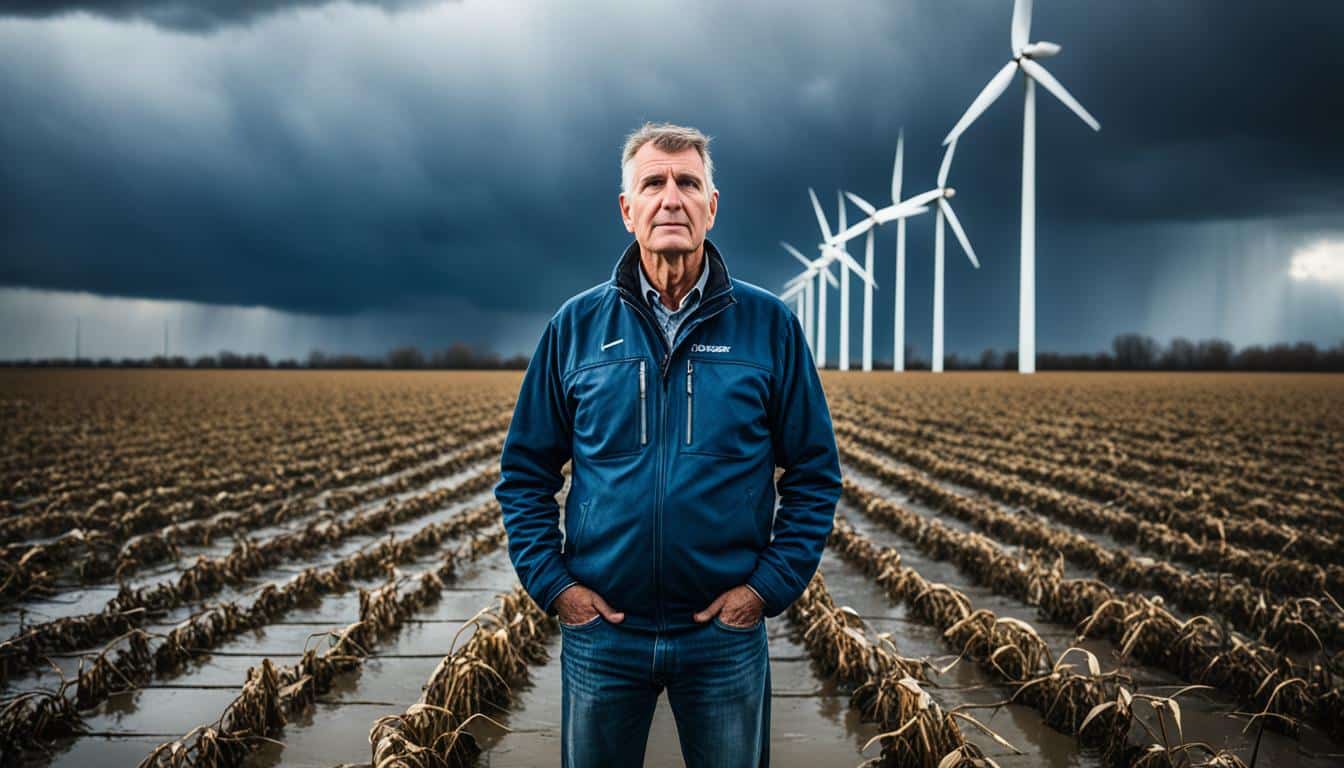
Did you know agriculture and food contribute over $750 billion to the U.S. GDP every year? This shows how big farming is for the economy. U.S. farms also provide nearly 25% of global grains, making them important worldwide. But, climate change brings challenges like warming temperatures and changing CO2 levels.
Farmers and ranchers deal with less harvests because of severe weather, like floods and droughts. These weather events risk food safety. In 2011, heat waves led to over $1 billion in losses for farmers. U.S. farmers also spend a lot, over $11 billion a year, to control weeds. With climate change, these costs may rise. This situation asks for new farming methods that are sustainable.
Agriculture relies deeply on the climate. Changes in climate elements like temperature and carbon dioxide can affect crop growth. Farming needs certain climate features like soil moisture and water to work well.
Climate change makes extreme weather more common and severe. These changes can challenge how and where we grow food. In the U.S., farmers who provide over $300 billion worth of food each year face serious risks.
| Aspect | Statistics |
|---|---|
| Economic Contribution of Agriculture | $300 billion annually |
| Grain Supply to Global Market | 25% of all grains |
| Meat and Poultry Consumption | 36 million metric tons annually |
| Agricultural Cash Receipts from Livestock and Poultry | $100 billion annually |
Facing these challenges, adapting to climate change is vital for farmers. The use of climate-smart agriculture initiatives is key. These methods combine sturdy farming, with high-tech solutions, helping reduce harm. This includes making soil healthier, widening the types of plants and animals we farm, and growing crops that can handle more extreme climates.
Agriculture is key to the U.S. economy. It goes beyond growing crops and raising animals, adding over $300 billion yearly. When we add jobs in food service and related industries, this figure jumps to over $750 billion. Besides this, agriculture supports nearly 25% of the worldwide grain market.
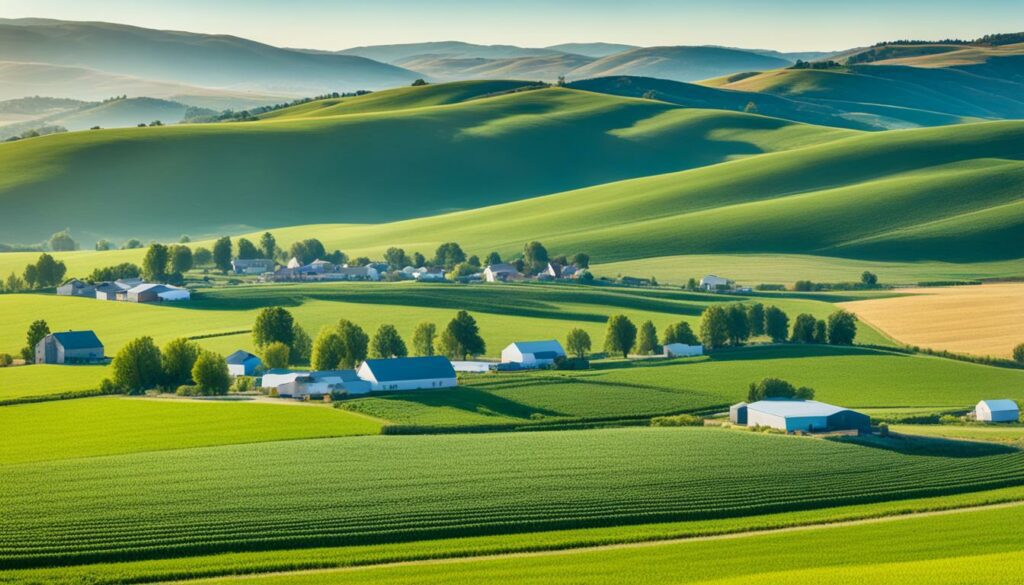
U.S. farms help supply the world’s grains. American fishermen boost the economy by $1.55 billion each year. They catch about five million metric tonnes of fish and shellfish.
Livestock and poultry are also vital, making over $100 billion annually. They meet the needs of the U.S. eating more than 36 million metric tonnes of meat and poultry each year.
But, climate change brings growing challenges. Heat waves in 2011 cost over $1 billion in losses. Extreme weather is a big issue, needing quick attention and new strategies.
Climate change negatively affects agriculture worldwide, posing serious food security risks. The balance between farm output, economy, and food safety is very delicate. Climate threats could lead to a major food crisis. In South Asia, wheat and maize production might drop by 30% by the end of the century.
| Indicator | Value |
|---|---|
| Annual contribution to economy from crops, livestock, and seafood | $300 billion |
| Total contribution to GDP | $750 billion |
| Global grain market supply | 25% |
| Annual losses from heat waves (2011) | $1 billion |
| Livestock and poultry annual cash receipts | $100 billion+ |
| Annual fish and shellfish harvest | 5 million metric tonnes |
The link between agriculture, the economy, and food safety is crucial. We must tackle climate challenges to protect these links and ensure global food safety.
Climate change affects crops in significant ways. It changes the temperature, CO2 levels in the air, and brings more extreme weather. This affects not just farming but also food production in the U.S. Understanding these changes is critical because agriculture and food make up over $750 billion of the U.S. economy each year.
Temperatures changes play a big role in how well crops grow. Some crops might do better, but others might suffer with more heat. In America, heat waves have already caused farmers to lose over $1 billion. The right temperature is very important for crops to do well. If it’s too hot or cold, it can hurt crop yields, especially in places where farming is already tough.
Carbon dioxide (CO2) in the air affects plants in interesting ways. More CO2 can make some crops, like wheat and rice, grow faster. But this good effect is often balanced out by problems like heat and not enough water. Even though more CO2 sounds good, real-life challenges can lower crop growth and their health. We can help by using water and nutrients wisely, increasing wheat farming in cooler areas by up to 40% more than usual.
Extreme weather, like floods or droughts, is a big problem for farming. These events can really hurt crop yields. And with climate change, we can expect farming’s challenges to grow. Studies show that, without changes, crop yields might drop by 7% to 23%. It’s important to test different strategies and study how various factors affect crop production. This helps farmers prepare and become more resilient to the changing climate.
Climate change is causing various issues for livestock, from heat stress to changing diseases. Livestock and poultry make up more than half of the U.S. agricultural cash receipts, topping $100 billion each year. The consumption of meat and poultry is high, with over 36 million metric tons eaten in the U.S. yearly. Yet, these numbers are now at risk because of climate changes.
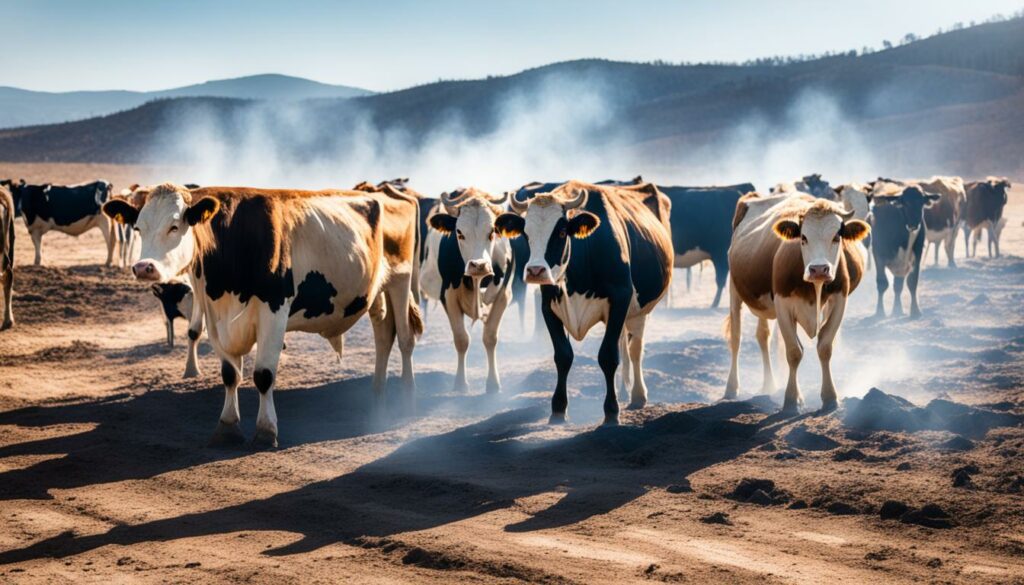
Climate change is making heat stress worse for animals. This is because heatwaves are becoming more frequent and intense. In 2011, heatwaves caused over $1 billion in losses for farmers. This heat stress lowers animal productivity, health, and welfare.
Cows that experience heat stress during pregnancy can have better heat tolerance. But, this doesn’t offset the short-term negative effects on production.
Climate change is also leading to more droughts and affecting feed supply. High CO2 levels lower the quality of forage. Droughts also make feed less available and of poorer quality. This creates nutritional challenges for livestock.
Producers face the challenge of managing the declining quality and scarcity of feed. This impacts the health and productivity of their livestock.
Climate change is a major cause of diseases in livestock. Warmer temperatures and changing weather spread parasites and diseases. This increases the risk from existing diseases and introduces new threats.
As the planet gets warmer, parasites and diseases spread further. This makes them more common and harder to control.
Producers need to adapt to these changing conditions to protect their livestock. By understanding how climate change affects them, they can take steps to keep their animals healthy and productive.
| Aspect | Impact | Consequence |
|---|---|---|
| Heat Stress | Increase in heat-related occurrences | Reduced productivity, health decline |
| Drought | Reduced water and feed availability | Compromised nutritional intake |
| Parasites and Diseases | Increased range and proliferation | Higher prevalence of livestock diseases |
Fisheries are key to the U.S. economy, adding over $1.55 billion yearly. Yet, they face growing threats due to climate change.
Climate change effects on fisheries are seen in shifting habitats. With temperatures increasing, species like the American lobster move north. They’ve been found up to 119 miles further north. Such shifts hurt old ecosystems and bring new competition among species.
Warmer oceans also mean more marine diseases. These higher temperatures help pathogens thrive, leading to more disease outbreaks. This situation endangers fish populations and the people who rely on them.
Ocean acidification’s impact is big too. More CO2 in the sea changes water chemistry. It weakens shellfish – which are vital for sea life – and causes harm to the shellfish industry, which heavily relies on them.
So, climate change adds many problems for the fishing industry. It brings changes in habitats, more diseases, and the big issue of ocean acidification. The sector must quickly adjust to the changing environment to continue supporting the economy and communities.
Farmers are turning to new ways to deal with climate change. These methods are key to keeping farms going strong despite the challenges the environment throws at them. They help protect the future of farming.
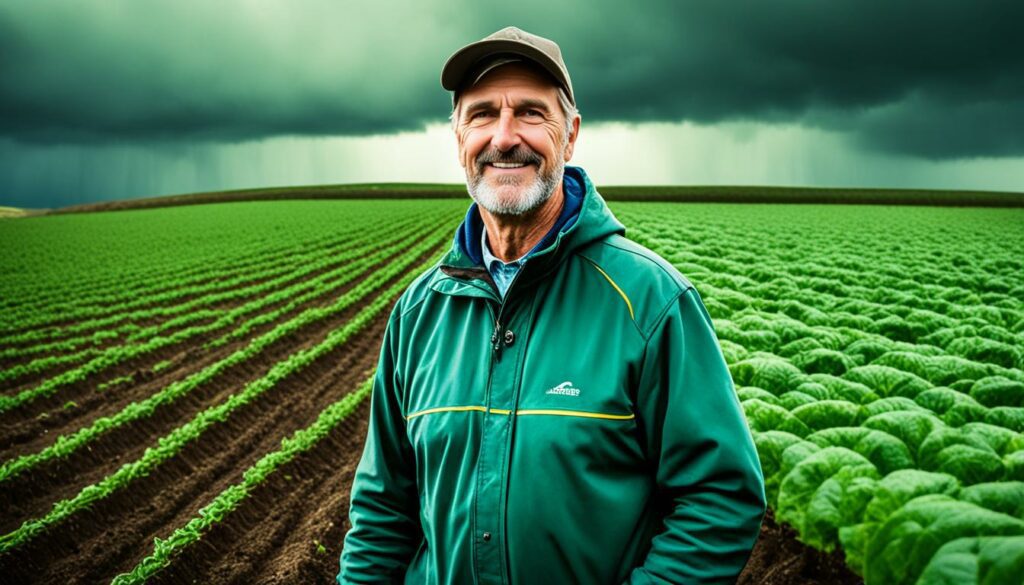
Farmers are working on making their land better for tougher times ahead. They’re doing this by improving the health of the soil. They use crop rotation and plant cover crops to keep the soil moist and stop it from washing away.
Adding different types of crops and trees to their fields is also important. This helps increase the number of plant and animal species, making the ecosystem more robust.
Studies have shown that these methods are not only good for the planet but also make farms more resilient. It’s clear that these steps are vital for ensuring there is enough food in the future.
New gadgets and tools are also playing a big role in farming. Things like GPS and sensors are helping farmers use water and fertilisers better. This means less is wasted, especially when the weather is unpredictable.
Breeding better, stronger crops is another focus. Scientists are working on creating plants that can withstand harsher weather and pests. This is an important step towards securing our food supply.
The American Farm Bureau says these new technologies can also make farming friendlier to the environment. They help farms produce more with fewer negative impacts.
It’s clear that combining smart farming methods with the latest tech is the way forward. This approach doesn’t just fight the consequences of climate change. It also safeguards the future of farming itself.
Tackling climate change is key in keeping agriculture sustainable for the long run. We must work on cutting down emissions from farms. Also, we need to improve how much carbon the soil can hold. This will help fight the bad effects of a changing climate and keep growing food in the future.
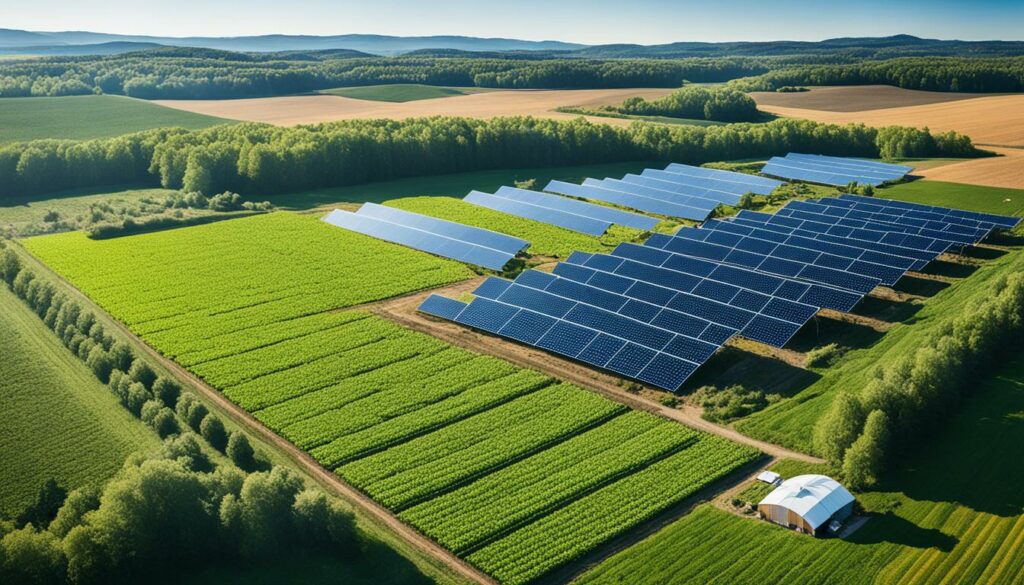
Farmers are finding ways to make the soil store more carbon. Cover crops and deep-rooted plants play a big part in this. They make the soil healthier and able to handle both droughts and heavy rains better.
Having a mix of crops and plants that stay for years also helps a lot. This mix stores more carbon. It lets farmers use less chemicals and have a stronger farm that reacts well to climate changes.
Cutting down on farm emissions is a major goal. This includes using new farming methods that are kinder to the planet. For example, creating crops and animals that can do well even as the climate changes. Plus, growing more trees can be a big help too.
Looking back at how people farmed traditionally is also gaining attention. This mix of old and new ways can be the best route to sustainable farming.
Backing local farmers and their ways is vital. It ensures everyone can have a say in making farming more sustainable. Giving support to groups who might have been left out before is key. Including everyone will make farming stronger against changes.
| Practices | Benefits |
|---|---|
| Cover crops | Improve soil and increase water retention |
| Deep-rooted perennials | Enhance carbon storage |
| Agroforestry | Reduce emissions, increase biodiversity |
| Integrated crop-livestock systems | Boost resilience to climate change |
Climate-smart agriculture is key to tackling climate change in farming. It looks to ensure food keeps coming and helps our planet. It’s known that farming, globally, causes about a third of all emissions. So, these projects work on making more food but harming nature less.
With food demand rising for our soon-to-be 9.7 billion people by 2050, we must act. The World Bank is now putting nearly $3 billion each year towards green farming. For example, it supports China’s move to greener agriculture with a $345 million loan. And in Punjab, their $200-million project is helping make farming more resilient and friendly to the earth.
Farming has often led to cutting down forests and losing plants and animals. It uses a lot of water and is the biggest maker of methane gas. But now, extreme weather from climate change can harm millions who depend on farming. So, new efforts aim to make farming tough in the face of change, while cutting pollution and making more food. They focus on things like reducing gas from cows and making farms ready for tough weather.
The World Bank is making sure its work follows the Paris Agreement from July 2023. This deal is a global promise to farm in ways that keep the earth safe. That’s big news for places like the U.S., EU, China, and India. Groups like Clover Sonoma and Starbucks are joining in to help farms, especially with the pollution from making dairy.
Funny enough, only 4% of money set aside for climate change gets to farms, and less to small ones. But now, more special efforts are starting. They focus on stopping nitrogen waste, learning how to keep soil healthy, and stopping ammonia gas. Big cash like the $621 million for Africa and the $125 million for making farming greener shows a real effort to fight climate change. It’s about making sure we always have food and a world that’s safe for all.
Farmers are facing many obstacles due to the changing climate. They are dealing with unpredictable weather, like sudden floods or droughts. These challenges make it essential for farmers to come up with new ways to grow their crops.
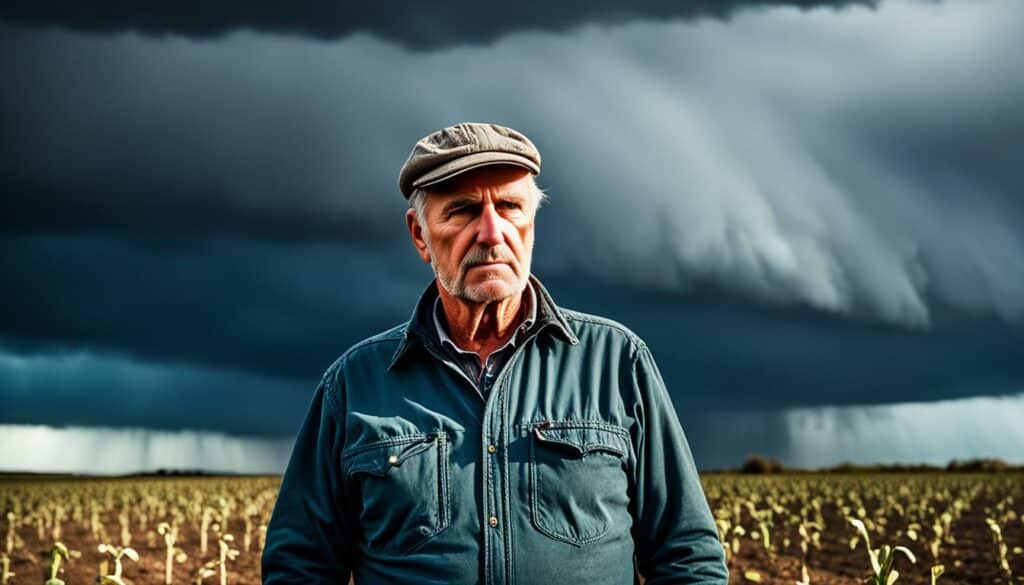
In 2011, high temperatures led to over $1 billion in losses for farmers. This big hit shows why it’s so important for farmers to adapt to climate change. U.S. farms are vital, supplying 25% of the world’s grains. But, they’re at risk because of more frequent extreme weather. It’s critical for farmers to include climate risks in their planning.
Changes in rainfall are another issue. There’s been a 10% drop in crop production because of climate change. This impacts the economy, with agriculture and fisheries adding over $300 billion a year. Floods and droughts only make this worse. That’s why helping farmers adapt is crucial for our economic health.
Climate change also affects livestock. More than $100 billion of U.S. agricultural income comes from livestock and poultry. They face their own set of problems, like heat stress and more parasites. Tackling these issues is essential for the survival of farming.
Agricultural productivity and climate change are deeply linked. The latter greatly affects crop yields. In the United States, the agriculture and food sectors add over $750 billion to the economy each year. But, climate change’s effects on crop yields could harm this key economic area.
Climate change affects agriculture in complicated ways. Changes in rain and more extreme weather events, like heat waves and heavy rain, stress crops. In 2011, heat waves led to over $1 billion in crop losses.
Climate change also shifts pest patterns, making farming harder. For instance, as temperatures rise, oyster parasites have spread further north on the Atlantic coast. This shows how climate change’s effects can indirectly affect various parts of agriculture.
To face these challenges, we need broad strategies that include new technologies and policies. These could increase crop yields significantly in the next few decades. For example, maize, sunflower, and soya beans could see a 30% yield boost by the 2050s in some places.
| Region | Expected Yield Increase (2050s) |
|---|---|
| Mid-latitudes | Nearly 10% increase for wheat |
| High latitudes | Up to 30% increase for cereals and cool season seed crops |
Policies must help farmers adopt smart farming methods. The Murray-Darling Basin, a big food producer in Australia, is key. It faces lower rain in winter and spring. A mix of strategies is vital to sustain farming and food security against climate change.
The impacts of climate change on farming worldwide are huge. It brings unpredictable weather and makes it harder to grow crops, especially in poorer areas. Sadly, the number of hungry people rose from 2015 to 2016, reaching 815 million.
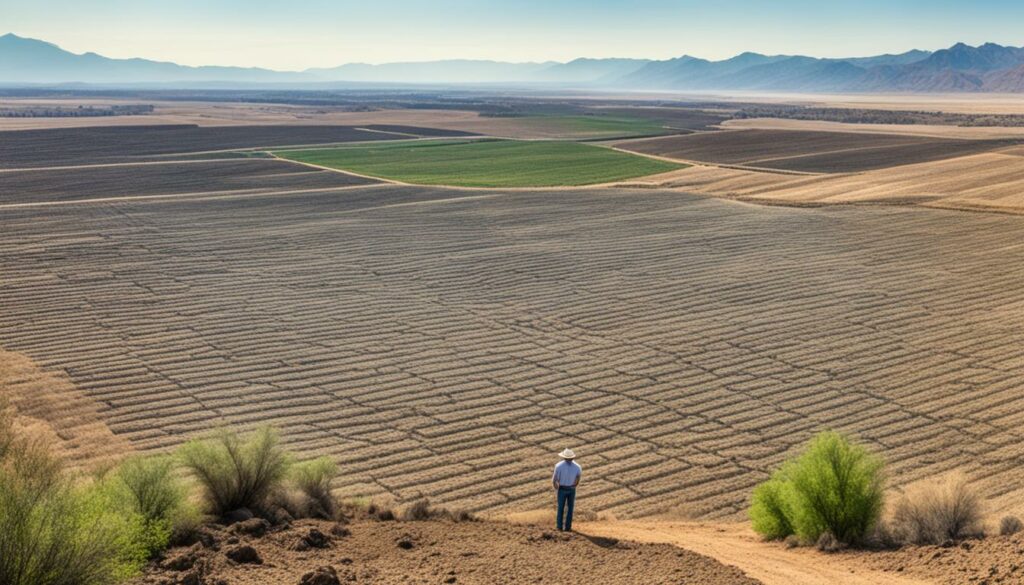
Climate problems don’t stop at one country’s border. Droughts, floods, and extreme weather hit everywhere, affecting food prices and trade. The effects of recent La Niña events have been devastating, with many regions facing food shortages.
| Year | Undernourished People (Millions) | Children ( | Crisis-Level Food Insecurity (Millions) |
|---|---|---|---|
| 2016 | 815 | 43% | 108 |
| 2017 | 821 | 43% | 124 |
| 2018 (proj.) | 821 | 43% | 124 |
To tackle this, countries need to work together on climate resilience. The United States, for example, is giving a lot of money to help. This support is crucial for fighting food crises and building stronger farm systems.
Climate change is already hurting farms all over the world. In Africa, for example, farm output has dropped by a third. A lack of rain is making things very tough in some places. But, working together, we can make farms more able to handle the changes.
Helping out isn’t just about money. It’s also about sharing what we know. Better farming techniques and crop types can make a big difference. They can stop kids from going hungry and help everyone eat better.
So, working as a team, we can make farming safer and more stable. Sharing ideas and making smart plans now can really help in the future. Sticking together is our best bet against the tough times ahead.
Government support for climate adaptation in agriculture is key. Public policies and programs help farmers tackle climate change issues. They do this by encouraging sustainable practices and by giving resources to cope with changing climates.
The seriousness of government action is clear. U.S. agriculture’s role in emitting gases shows a need for change. Since agriculture contributes a lot to U.S. greenhouse gases, focused government help is necessary for cutting these emissions.
Governments help in many ways to adapt to climate change. As the Earth gets warmer and rainfall changes, farming must change too. For example, by promoting crops that need less water, like the drought-tolerant corn, the U.S. has reduced the impact of these changes on farming.
Encouraging green farming is very important too. Programs like the Conservation Reserve Program (CRP) offer money for good environmental practices. This can help to lower greenhouse gases by doing things like conservation tillage, which stores more carbon.
| Type of Emission | Percentage | Reduction Practices |
|---|---|---|
| Nitrous Oxide | 46.6% | Using slow-release fertilisers or nitrification inhibitors |
| Methane | 41.5% | Changing livestock feeds, installing digesters |
| Carbon Dioxide | 11.9% | Adopting no-till practices, reducing fuel use |
Measures like the Renewable Fuel Standard help farmers focus on making biofuels or providing land for green energy. These steps push towards farming practices that help fight climate change.

The agricultural sector in the United States is worth over $300 billion every year. In total, farming and food add more than $750 billion to the economy. This shows how important it is to look ahead and plan for the effects of climate change. These plans need to cover everything from temperatures and rainfall to how we’re affecting the environment.
Creating dynamic plans that rely on data is key in farming’s fight against climate change. Even with new farming technologies, extreme weather can still lower crop yields. In Iowa, for example, climate change is expected to cause a 5% drop in corn production by 2030.
Another big issue is the cost of dealing with weeds, which adds up to over $11 billion every year. Weeds and pests are expected to become even more of a problem as the climate changes. Livestock may also suffer more from diseases, making it critical to plan ahead in these areas too.
Not just crops and livestock, but fishing is also hit by climate change. Some fish species have already started moving north. This shift is a big sign of how much the climate can affect different parts of the economy. It’s clear that close attention and smart planning are needed in all areas of agriculture.
Looking at our main food crops in particular, the future is challenging. Even though we’ll be producing more overall, the efficiency of this production is dropping because of climate change. So, our plans must be about both lessening these negative effects and making our systems strong for the long term.
The financial side of farming is also under pressure. The U.S. may soon face a bigger loss in agricultural trade, showing the urgency for strong, forward-looking plans. Protecting our farming industry is critical for our economy’s health and stability.
We need detailed, up-to-date strategies to face the issues of climate change head-on. By planning well and using new information, we can hope to make U.S. agriculture both strong and resilient for the future.
As we wrap up exploring how climate change affects farming, it’s clear we must act fast. Many groups, like people of colour and those with little money, are at bigger risk. Helping them with housing, food, and more is key.
To keep farms going, we need to invest in local areas and help those hit by climate change. By planting certain crops, the soil can deal better with too much or too little water. This makes farming stronger against climate pressures.
Changing farms to have more types of plants and trees can make them better at dealing with climate change. It’s also important to create new types of crops and animals that can survive a changing climate. We should aim to stop producing gases that warm the planet. This will help agriculture fight climate change from its roots.
The world’s food supply is at risk, with over 10% of people not getting enough to eat. Experts say the Earth’s average temperature could rise by 0.4 to 2.6°C by the late 2100s. To protect farming, we need everyone working together. We should use new technology, policies, and farming methods to make sure we have enough food in the future.
Climate change changes farming by altering temperatures, CO2 levels, and extreme weather. These changes can disturb crop growth, food safety, and the economy.
In the U.S., agriculture directly brings in over 0 billion yearly. This industry also boosts more than 0 billion from related businesses. Yet, climate change can harm this income by impacting harvests, raising costs.
To adapt, farmers should improve soil, use diverse crops, and breed plants that handle climate change better. They can also use advanced farming methods.
More CO2 can help plants grow, but their benefits might be limited by other negative effects of climate change. These include fluctuating temperatures, lack of nutrients, and less water.
Climate change can cause heat stress, lower productivity, food shortages, and more health problems in animals. This affects both the animals and the people who depend on them.
Fisheries face troubles like changing habitats, shifts in where fish live, the spread of diseases, and higher acidity in oceans. These challenges affect fishing and sea life.
To be sustainable, agriculture should focus on trapping carbon in the ground and in trees. It also means acting in ways that do not harm the environment.
Climate-smart agriculture aims to grow more food sustainably, make farms tougher against climate change, and cut down on harmful gases. This helps ensure there’s enough food in a changing world.
Changing climate brings new rain patterns and more extreme weather events. Farmers must find and use new ways to deal with these dangers.
Floods and droughts can damage crops severely. This increases how much crop harvests might suffer from changing weather, putting food at risk.
Global work is key to fighting climate change on farms. It lets people share ideas and work together, making it easier to face these big challenges everywhere.
Governments can support farm changes, offer money for going green, and set rules that help farms handle climate change better. This support is crucial for farmers.
Planning ahead helps deal with changing temperatures, rain, and the impact of gases like CO2. Good planning makes farms strong for the future.